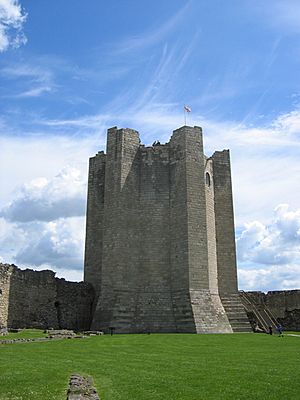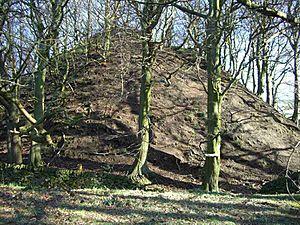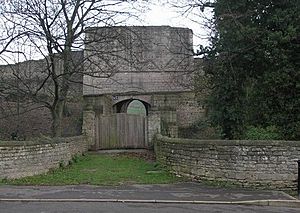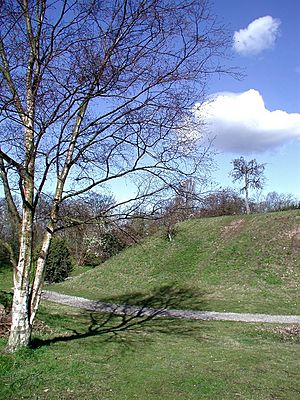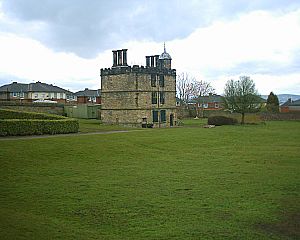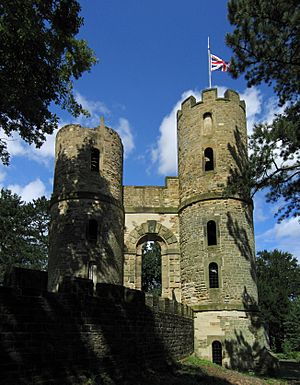Castles in South Yorkshire facts for kids
South Yorkshire has many castles, but most of them were not the huge stone fortresses you might imagine. Instead, many were manor houses or a type of castle called a motte-and-bailey. These were very common in England after the Normans took over in 1066. They were built to help the new rulers control the land.
Contents
Exploring South Yorkshire's Castles
Beighton Castle
Today, Beighton is a part of Sheffield. But a long time ago, in the Middle Ages, it was just over the border in Derbyshire. We only know about its castle from a single old document from the 1200s. This document mentions "the tower of the former castle." We don't know exactly where it was. However, old maps from the 1700s show a spot near the River Rother. This area might have had a moat around it.
Bradfield Castle
Bradfield is located north-west of Sheffield. Two places in the village are thought to have been castles. One is called Bailey Hill. It's a 60-foot-high (18 m) motte, which is a large mound of earth. In the 1700s, people dug there and found stone, suggesting the castle might have been rebuilt in stone. Its lower area, called a bailey, covered about three-quarters of an acre. The ditch and rampart (a defensive bank) around it are still 30 feet (9.1 m) high! The village of Bradfield grew up around this castle, which was connected to Sheffield Castle. This site is now a protected historical site.
Another nearby spot, Castle Hill, might have been a ringwork (a circular earthwork), a natural lookout point, or even a siege work (a temporary fort built during a siege). This hill, which could also be a motte, has been quarried (meaning stone was dug out of it). But one old source says that parts of a keep (the main tower) could still be seen there in 1819.
Conisbrough Castle
Conisbrough Castle was built in the 1100s. Its most impressive part is the 100 ft (30 m) tall round keep. This tower is supported by six strong buttresses (stone supports). In the mid-1990s, the keep was repaired. A new wooden roof and two floors were put back inside. This castle is one of South Yorkshire's most popular places to visit. More than 35,000 people come to see it every year!
Doncaster Castle
Doncaster Castle was built where the town's old Roman fort used to be. It was right next to the River Don. The castle stood on a motte, which is now under the eastern part of St George's Minster (a large church). This motte was surrounded by a 16-foot (4.9 m) deep and 30 feet (9.1 m) wide ditch. This ditch later became the boundary of St George's churchyard. The castle was torn down, probably in the 1100s, so there are no visible parts left today.
Hickleton Castle
Hickleton is west of Doncaster. Its castle was a motte and bailey type. We know about it from a drawing made in the 1600s by a person named Roger Dodsworth. Sadly, the site was later destroyed by quarrying (digging for stone). Because of this, you can't see any remains of the castle today.
Kimberworth Castle
Kimberworth is west of Rotherham. Its castle was a wooden motte and bailey castle. It was connected to Tickhill Castle. The motte (earth mound) is still there. However, there are no visible signs of the bailey (the lower courtyard). The castle was never rebuilt with stone. This site is now a protected historical site.
Laughton Castle
Laughton-en-le-Morthen is south-east of Rotherham. Laughton Castle was a motte and bailey castle that also depended on Tickhill Castle. It was probably built where a hall owned by Edwin, Earl of Mercia once stood. The motte is still there, and so is a ditch that surrounded the bailey. The castle was likely first built by Roger de Busli. It might even be older than his castle at Tickhill. This site is also a protected historical site.
Langthwaite Castle
Langthwaite used to be north of Doncaster. The village is now gone, but the castle site is near Adwick-le-Street. This was another motte and bailey castle. The motte is still there, though it's not as tall as it once was. A 40-foot (12 m) wide ditch shows where the bailey used to be. This site is a protected historical site.
Mexborough Castle
Mexborough is north of Rotherham. Its castle was a wooden motte and bailey type, connected to Tickhill Castle. The motte and the earthworks of the bailey are still there. You can visit them in a public park called Castle Hills Park during the day. This castle was never rebuilt in stone. Even though it's smaller now, the motte is still 52 feet (16 m) high. It's surrounded by a six-foot bank and a 50 ft (15 m) wide ditch. This site is a protected historical site.
Sheffield Castle
The first Sheffield Castle was a wooden motte and bailey castle. It was built for William de Lovetot in the early 1100s. This first castle was destroyed in 1266 during a conflict called the Second Barons' War. The rest of the town was also damaged. A bigger stone castle was built in its place in 1270. However, this stone castle was badly damaged during the English Civil War. Most of it was torn down in 1648.
Skellow Castle
Skellow is north-west of Doncaster. Its castle was a motte and bailey type. The motte is still there, located in the grounds of Skellow Hall. You can also see part of the earthworks of the bailey in a field to the north. This site was used again during the English Civil War. It is now known as Cromwell's Batteries. This site is a protected historical site.
Tickhill Castle
Tickhill Castle was a very important stronghold (a strong fort) during the time of King John I of England.
Thorne Castle
Thorne is north-east of Doncaster. Its castle was a motte and bailey type. It was connected to Conisbrough Castle. The motte is still there and is now called Peel Hill. A ditch around the motte also remains, and a few pieces of old walls have been found. The castle might have also been used as a hunting lodge for Hatfield Chase. The tower, which was made of stone, lasted until at least the 1400s. A writer named John Leland wrote that "by the church garth of Thorne is a praty pile or castelet, well diked, now used for a prison for offenders in the forestes." Most of the castle's foundations were removed in the 1820s. This site is now a protected historical site.
Houndhill
Houndhill is in Worsbrough, near Barnsley. This house still has two sides of its old mediaeval (Middle Ages) fortification walls. It also has two of its original four turrets (small towers). During the English Civil War, this fortified manor house was defended by fifty armed men. The Elmhirst family, who owned the house during the Civil War, still own it today.
Manor Lodge
Stainborough Castle
Stainborough Castle is in the grounds of Wentworth Castle. It's actually a folly. A folly is a building made to look like a real castle, but it's just for decoration. This one was built starting in 1726 and has "Rebuilt in 1730" written on it. It was one of the very first fake castles in an English garden!
Wentworth Castle
Wentworth Castle, near Barnsley, used to be a grand stately home. It was the main home of the recreated Earls of Strafford.


